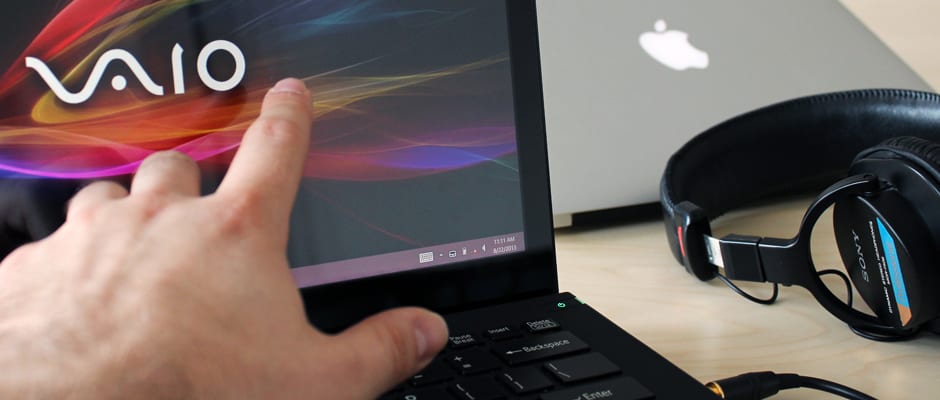Pros
Cons
I had a similar conversation in my head when I first saw the Sony VAIO Pro 13 (MSRP $1249.99) at a local electronics shop, which either means I'm crazy or that Sony's latest ultrabook impressed me with its appearance. Let's hope it's the latter.
After we received a review model, I was blown away by its weight—this has to be the lightest laptop I've ever used. Somehow Sony's featherweight ultrabook packs a fourth-generation Intel Core i5 processor (aka Haswell), 4GB of RAM, a 128GB solid-state hard drive, and two USB 3.0 ports.
Wait a minute, I just described Apple's latest MacBook Air.
Aside from operating systems, the three major differences between these laptops are quality of touchpads (Apple wins here), the addition of a touchscreen on the Pro 13, and price: $1249 for Sony's 13-inch versus $1099 for Apple's. Sony's svelte ultrabook is starting to look bloated.
Design & Screen
Body by Sony
You can have a super-powerful laptop that's capable of playing Crisis 3 and editing movies at the same time, but if it isn't portable, what's the point? Sony understands this concern, and has made one of the most transportable laptops ever. Seriously, this thing is light. The 13-inch VAIO Pro weighs in at just 2.92 pounds with the AC adapter, thanks to its carbon fiber construction. Yes, Sony crafted this ultrabook from a material not named plastic. In fact, it's safe to say that the Pro 13 is the opposite of Sony's Fit line: thin and well-built, as opposed to thick and plasticky.
The design isn't perfect, though. The bottom corners of the laptop, below the touchpad, are kind of sharp. You won't cut yourself on them, but you will be displeased if your palms graze them.
Speaking of the touchpad, it's frustrating. Sony gives you ample room to play with, but the overall responsiveness of its touchpad is disappointing. The two-finger scroll—my absolute favorite gesture—is inconsistent: sometimes it works fine, other times it's jumpy. On top of that, Sony doesn't let you change the default inverted scroll. And since Windows 8 supports gestures on touchpads, you'll have a hard time pulling them off on this flaky peripheral.
{{ gallery "design" }}
That's where the touchscreen comes into play. Like the Fit, the Pro 13 features a non-detachable touchscreen. It's actually quite responsive and makes Windows 8 gestures a breeze to pull off. Unfortunately, the only gesture I found myself using was the right-side swipe that brings up settings necessary to power the Pro 13 off. I'm still not sold on laptops with touchscreens that can't detach into tablets.
Sony makes up for some of its hardware missteps with an excellent backlit keyboard. The chiclet-style keys are spaced perfectly, and have a satisfying amount of travel. I rarely made typing errors while using the Pro 13—it's just as comfortable, if not more, than the Mac Air's keyboard.
Port selection is nothing out of the ordinary. The right side includes two USB 3.0 slots, an HDMI output, a headphone jack, and an SD card reader; the left side merely has a power input. And for the true geeks, Sony includes NFC (near field communication) support on... the touchpad. By placing your NFC-enabled phone over the touchpad, you can send pictures to the Pro 13—in theory, at least. In practice, it kept telling me that my 1MB photos were too big to send. I'm not too disappointed, though—NFC is mostly a neat parlor trick, not a truly useful feature.
Software
An awkward touchscreen experience
Windows 8 is a touch-oriented operating system—upon first glance, at least. When you boot up any Windows 8 computer, you're greeted by the Start screen, which is populated by squares and rectangles—called Live Tiles—for various apps. This screen feels clumsy to traverse with a mouse, but with your fingers? It's a pleasure to use.
One of the first tiles you see on the Start screen is labelled "Desktop," and it brings users to a more familiar "desktop" environment. Best of both worlds, right? Whether you love or hate Windows 8 is no fault of the Pro 13. I spend most of my time in Desktop mode, so the touch-friendly Start screen is rarely something I deal with.
Sony includes a few programs for free with its little ultrabook. Worst among them is the Kaspersky anti-virus software. I thought Norton was bad, but Kaspersky takes annoying and invasive to a new level. It seemed like everything I did on the VAIO Pro 13 caused Kaspersky to open a window, warning me of some terrible consequence. Removing this program made the user experience that much better.
On a lighter note, Sony packages a drawing app called ArtRage with the Pro 13. This program utilizes the touchscreen to draw whatever is on your mind, using a multitude of different brushes. The actual experience is kind of fun, but lessened by the non-detachable screen. Seriously, try drawing something with your finger on a laptop screen—it's awkward. If this were a tablet, ArtRage would be much more fun. At least it let me draw a green cat.
{{ gallery "software" }}
One other piece of software to note is Sony's VAIO Care. This is simply an interface that warns you of security risks and alerts you to current updates. Windows 8 does a pretty good job of updating itself, so I found VAIO Care to be somewhat unnecessary. The only time it's truly useful is when it updates core Sony drivers for the touchpad or BIOS, but that's few and far between.
Performance
Lacking a bit of "ultra"
Sony's Pro 13 is a capable laptop that can handle a steady workload (as long as said workload doesn't involve games). The obvious question is how it compares to that other lightweight, razor-thin ultrabook: Apple's MacBook Air. Since this touchscreen beauty costs about $150 more than Apple's competitor, you'd think it would have slightly better performance results. That is not the case, unfortunately.
We use an assortment of benchmarking programs and real-world tests when reviewing laptops. Processor-gauging tests like PCMark and Geekbench place the Pro 13 neck-and-neck with the MacBook Air; the use of applications like Photoshop and Handbrake—a video conversion tool—give the edge to Apple, but just slightly.
The real division in performance is how these ultrabooks handle video processing. We test this using 3DMark Vantage, which throws a number of graphically-intensive videos at our review models. The VAIO Pro 13 produced lackluster results here, and was trounced by the Air. To be fair, we loaded up Portal 2 and clocked the framerate with most video settings cranked. Again, the Pro 13 produced shrug-worthy numbers.
One area that Sony's latest excels in is battery life. Like the current MacBook Air, the Pro 13 has Intel's fourth-generation processor. What this means is increased battery life because Intel's latest gauges the need for hardcore processing. The processor will cruise along at 1.60GHz, unless a task requires more power, which means the speed is cranked to 2.60GHz. We dimmed the screen brightness to 50% and refreshed a website every two minutes, resulting in a battery life of over nine hours. This is incredible for a laptop. Unfortunately for Sony, the Air gets about 13 hours in this test.
The Verdict
If this were $250 less...
When it comes to design, the Sony VAIO Pro 13 is a clear winner. Its carbon fiber construction exudes style, plus whatever bag you toss it into won't weigh you down. If only I could heap praise upon all aspects of the Pro 13, though. Aside from its excellent exterior, this ultrabook isn't very impressive.
I hate to keep bringing up the MacBook Air, but Apple's latest trumps the VAIO Pro 13 in almost every category—and costs $150 less. The only reasons to choose this over Apple's ultrabook are for fashion or operating system preference. It really is a shame—this laptop is gorgeous.
Unfortunately, its touchpad is incredibly frustrating—you'll be begging for a mouse after 30 minutes. For $1249, I can't recommend this over the Air, or even the less-sexy-more-functional Samsung ATIV Tab 7.
Meet the tester
An enthusiast of all things tech, Josh is one of Reviewed.com's resident television experts. When he's not looking at bright TV screens in a dark room, he's probably reviewing a laptop or finding a new snack at 7-11.
Checking our work.
Our team is here to help you buy the best stuff and love what you own. Our writers, editors, and experts obsess over the products we cover to make sure you're confident and satisfied. Have a different opinion about something we recommend? Email us and we'll compare notes.
Shoot us an email

